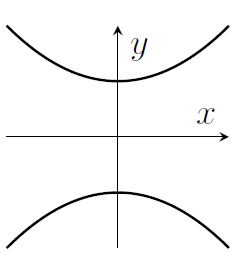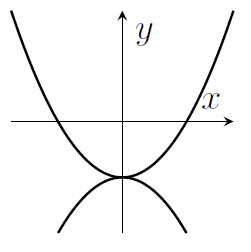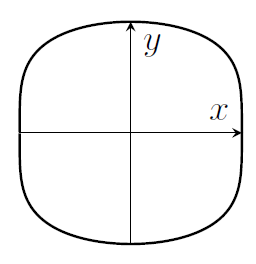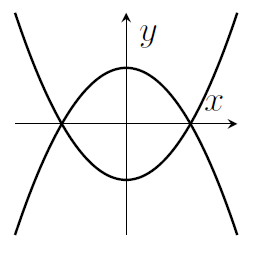Algebra - 2021
Part of the Oxford MAT Livestream
MAT syllabus
Simple simultaneous equations in one or two variables. Solution of simple inequalities. Binomial Theorem with positive whole exponent. Combinations and binomial probabilities.
Revision
- Given two linear equations for $x$ and $y$ like $2x+3y=7$ and $3x+5y=9$, solve by rearranging the first for $x$ and substituting that into the second equation, then rearranging the resulting equation for $y$, before back-substituting for $x$.
- We can add and subtract from each side of an inequality.
- We can multiply each side of an inequality by a number, but if we multiply by a negative number then the direction of the inequality changes. For example, $-6<-3$, but when we multiply both sides by $-1/3$ we need to flip the sign to get the true statement $2>1$.
- Squaring each side of an inequality is like multiplying, and need to be careful about cases where that's positive or negative. For example, $-2<-1$, but squaring each side would be like multiplying both sides by a negative number. Worse, $-1<3$ and $-3<1$, and squaring would be like multiplying the left by a negative number and the right by a positive number.
- (Binomial Theorem) If $n$ is a positive whole number then \[(x+y)^n=x^n+nx^{n-1}y+\dots+\binom{n}{r} x^r y^{n-r}+\dots+nxy^{n-1}+y^n\]
- where $\displaystyle \binom{n}{r} = \frac{n!}{r!(n-r)!}$ and $n!$ means $n\times (n-1)\times (n-2)\times\dots \times 2 \times 1$ for a whole number $n$.
- (Combinations) Given $n$ different items, there are $\displaystyle \binom{n}{r}$ ways to choose $r$ of them.
- Proof of the above; suppose we list the $n$ items and take the first $r$ items on the list. There are $n!$ ways to list the items, but we've over-counted the ways to choose $r$ items because it doesn't matter what order the first $r$ are in, and it doesn't matter what order the other $(n-r)$ items are in. The way to fix all this over-counting is to divide; each real set of $r$ items appears in the above plan $r!(n-r)!$ times; the first factorial allows for all the separate orders of the $r$ items, and the other allows for all the orders of the $(n-r)$ items. So final answer is $\displaystyle \frac{n!}{r!(n-r)!}$.
- If the order of the items chosen matters (e.g. if we're choosing who wins a prize, who comes second, and so on) then we should only allow for over-counting from the irrelevant orderings of the $(n-r)$ other items, giving final answer $\displaystyle\frac{n!}{(n-r)!}$.
- (Binomial probabilities) If $n$ independent events each have probability $p$ of success and probability $q$ of failure, with $p+q=1$, then the probability of exactly $r$ successes is $\displaystyle\binom{n}{r} p^rq^{n-r}$ for $0\leq r \leq n$.
Warm-up
- Solve the simultaneous equations $x+4y=1$ and $2x-y=3$.
- Solve $x^2+2x+xy+y^2=5$ and $x+y=2$.
- Solve $x^2+y=1$ and $x+y^2=1$.
- For which values of $x$ is it true that $x^2+4x+3>0$?
- Expand $(2x+3y)^3$
- Given $-2<a<1$, what can you say about $a^2$?
- Given $a<b$ and $c<d$, what (if anything) can you say about the relationship between $ac$ and $bd$? What (if anything) can you say if you're also told that $a>0$ and $c>0$?
- I'm going to flip five fair coins (each is heads or tails with equal probability, and each is independent of the others). What's the probability that I get exactly three heads?
- Check that the binomial probabilities $\displaystyle \binom{n}{r}p^rq^{n-r}$ for $0\leq r \leq n$ add up to 1.
- I've got six cards that have the numbers one to six on them. I'm going to shuffle them and then deal them out from left to right.
- What's the probability that the cards alternate between odd and even numbers (either starting with an odd number or an even number, then switching between odd and even for each subsequent card)?
- What's the probability that the first three cards I deal out are all prime numbers?
- What's the probability that the first two cards I deal out are both prime numbers?
- What's the probability that the first five cards I deal out are all prime numbers?
MAT questions
MAT 2014 Q1A
The inequality
\begin{equation*}
x^{4}<8x^{2}+9
\end{equation*}
is satisfied precisely when
(a) $-3<x<3$,
(b) $0<x<4$,
(c) $1<x<3$,
(d) $-1<x<9$,
(e) $-3<x<-1.$
Hint: change variable and be really careful with the fact $-1<x^2$.
MAT 2013 Q1D
Which of the following sketches is a graph of $x^4-y^2=2y+1$?
(a) 
(b) 
(c) 
(d) 
Hint: rearrange and be careful with square roots!
MAT 2014 Q1G
Let $n$ be a positive integer. The coefficient of $x^{3}y^{5}$ in the expansion of
\begin{equation*}
(1+xy+y^{2})^{n}
\end{equation*}
equals
(a) $n$,
(b) $2^n$,
(c) $\displaystyle \binom{n}{3} \binom{n}{5}$,
(d) $\displaystyle 4\binom{n}{4}$,
(e) $\displaystyle \binom{n}{8}$.
Hint: Imagine this as $(1+(xy+y^2))^n$.
MAT 2016 Q2
Let
\begin{equation*}
A(x)=2x+1,\quad B(x)=3x+2.
\end{equation*}
(i) Show that $A(B(x))=B(A(x)).$
(ii) Let $n$ be a positive integer. Determine $A^{n}(x)$ where
\[
A^{n}(x)=\underset{n\text{ times}}{\underbrace{A(A(A\cdots A}}(x)\cdots ).
\]
Put your answer in the simplest form possible.
A function $F(x)=108x+c$ (where $c$ is a positive integer) is produced by repeatedly applying the functions $A(x)$ and $B(x)$ in some order.
(iii) In how many different orders can $A(x)$ and $B(x)$ be applied to produce $F(x)$? Justify your answer.
(iv) What are the possible values of $c$? Justify your answer.
(v) Are there positive integers $m_{1},\ldots ,m_{k},n_{1},\ldots,n_{k}$ such that
\[A^{m_{1}}B^{n_{1}}(x)+A^{m_{2}}B^{n_{2}}(x)+\cdots
+A^{m_{k}}B^{n_{k}}(x)=214
x+92\qquad \text{for all }x\text{?}
\]
Justify your answer.
Hints: In part (ii) you could try some small values of $n$ to see what's going on before tackling the general problem. You might need to remember a fact from a the sequences and series material.
In part (iii) we're looking at different combinations of $A$ and $B$ - what's the coefficient of $x$ when we combine $A$ $m$ times with $B$ $n$ times?
In part (iv) remember that $A(B(x))=B(A(x))$.
In part (v), don't explore small cases, look for a property that the constant $c$ always has after we've applied $A$ $m$ times and $B$ $n$ times.
Extension
The following material is included for your interest only, and not for MAT preparation.
The outcome from applying the same function lots of times can be very complicated to work out. Let's consider what happens when the function $f(x)=4x(1-x)$ is applied lots of times, starting with a number between 0 and 1. There are different behaviours that we could look for, such as whether any particular number stays the same after $f$ is applied.
You can use quadratic equations to find two numbers that each satisfy $f(x)=x$. If $4x(1-x)=x$ then $x=0$ or $x=\frac{3}{4}$. Those are called ``fixed points" because they don't change when you apply $f$.
Now consider numbers $x$ and $y$ that satisfy $f(x)=y$ and $f(y)=x$, so $y=4x(1-x)$ and $x=4y(1-y)$. This is a pair of simultaneous quadratic equations, which can be tricky, but we can solve them. If we plug in the expression for $y$ into the second equation, we get
$$
x=16x(1-x)\left(1-4x(1-x)\right)
$$
which means that $x=0$ or (after multiplying out and rearranging)
$$
4x^3-8x^2+5x-1=0
$$
This cubic must have $\frac{3}{4}$ as a root, because $x=y=\frac{3}{4}$ is a solution to the pair of equations we're trying to solve. Dividing the cubic by $\left(x-\frac{3}{4}\right)$, we find a quadratic with two other roots; $\displaystyle\frac{1}{8}(5\pm \sqrt{5})$.
Those two roots are special because they satisfy $f(x)=y$ and $f(y)=x$ with $x\neq y$. That structure is called a "2-cycle" because as we apply $f(x)$ the numbers cycle between those two values. That's pretty cool behaviour!
However, there's a massive issue - if you actually try this on your calculator, you'll find that after a few iterations, the numbers drift away from the 2-cycle, and you start to get pseudo-random nonsense out. That's (partly) because your calculator makes tiny rounding errors each time, and then this function blows up those tiny differences into huge differences. This sensitivity is a characteristic of a chaotic system.
Separately, there's something in number theory called the Collatz conjecture, which is a question about the following function defined on whole numbers;
\[
f(n)=\begin{cases}
\frac{n}{2}\quad &\text{if $n$ is even}\\
3n+1\quad &\text{if $n$ is odd}
\end{cases}
\]
The question is; given a starting positive whole number $N$, if you apply $f$ repeatedly, working out $f(N)$ and $f(f(N))$ and so on, do you eventually get to the number 1, regardless of $N$?
At the time of writing, nobody knows.

